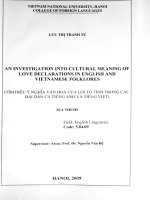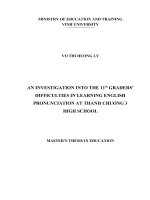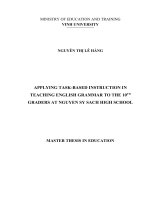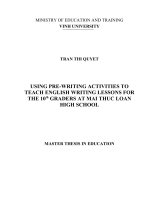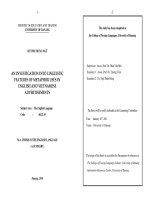An investigation into the use of group work in teaching speaking skill to the 11th graders at Bo Trach 1 high school
Bạn đang xem bản rút gọn của tài liệu. Xem và tải ngay bản đầy đủ của tài liệu tại đây (503.59 KB, 106 trang )
MINISTRY OF EDUCATION AND TRAINING
VINH UNIVERSITY
-----------o0o------------
TRỊNH LINH GIANG
AN INVESTIGATION INTO THE USE OF GROUP WORK
IN TEACHING SPEAKING SKILL TO THE 11th
GRADERS
AT BO TRACH 1 HIGH SCHOOL
MASTER’S THESIS IN EDUCATION
MINISTRY OF EDUCATION AND TRAINING
VINH UNIVERSITY
-----------o0o------------
TRỊNH LINH GIANG
AN INVESTIGATION INTO THE USE OF GROUP WORK
IN TEACHING SPEAKING SKILL TO THE 11th GRADERS
AT BO TRACH 1 HIGH SCHOOL
Major: Teaching English to Speakers of Other Languages (TESOL)
Code: 60.14.01.11
MASTER’S THESIS IN EDUCATION
Suppervior:
Ngơ Đình Phương, Assoc. Prof., Ph.D
NGHỆ AN, 2014
STATEMENT OF AUTHORSHIP
I hereby acknowledge that this study is my own work. The data and findings
discussed in the thesis are true, used with permission, and have not been published
elsewhere.
Author
Trịnh Linh Giang
i
ACKNOWLEDGEMENTS
I would like to acknowledge the assistance I received from a number of
people in the course of carrying out the research paper. I highly treasure the
important role they played in making the completion of this minor thesis a success.
In the first place, I would like to express my deep gratitude to my supervisor
Prof.Dr. NGƠ ĐÌNH PHƯƠNG, Head of Post-Graduate Studies Department of
Vinh University, for he close guidance, criticism, and he generous help in the
process of completing my thesis.
I am also greatly indebted to all the teachers and students at Bo Trach 1 high
school where the investigation was carried out for their endless enthusiasm,
valuable advice and great cooperation.
Finally, I wish to thank my family and all my friends for their support during
my completion of this study.
ii
ABSTRACT
For some recent years, English has played more and more important part in
Vietnam, therefore, it has been taught in schools as a compulsory subject. So far,
there have been remarkable changes in the way of teaching and learning English.
However, English teaching in general and teaching speaking in particular still is far
from satisfactory. How to motivate students to speak is really necessary, and is a big
question to almost teachers in Vietnam now. It is also the question that has inspired
me to investigate the use of group work in teaching speaking skill to the 11th graders
at high school.
The research approach undertaken by this study is mostly quantitative. Two
data collections instruments are used: students’ and teachers’ questionnaire surveys;
students’ and teachers’ interviews. Both qualitative and quantitative methods were
employed to create a realistic and detailed description of the real teaching context
and the attitudes, assessments of teachers and students involved.
This research investigated the difficulties in using group work activities in
English speaking lessons at Bo Trach 1 high school – Quang Binh province. At the
end of the thesis, some suggestions for conducting group work have been given.
Some newly arising problems were also pointed out for further research.
iii
TABLE OF CONTENT
Content
STATEMENT OF AUTHORSHIP
ACKNOWLEDGMENTS
ABSTRACT
TABLE OF CONTENTS
LIST OF ABBREVIATIONS
LISTS OF TABLES
CHAPTER 1. INTRODUCTION
1. Rationale
2. Aim and objectives of the study
3. Scope of the study
4. Research questions
5. Organization of the study
CHAPTER 2. LITERATURE REVIEW
2.1. Previous Studies Related to the Topic
2.2. Communicative language teaching(CLT)
Page
i
ii
iii
iv
viii
ix
1
1
2
2
3
3
4
4
6
2.2.1. Definitions of CLT
6
2.2.2. Characteristics of CLT
8
2.2.3. Principles of CLT
11
2.3. Speaking skill
2.3.1. Definitions of speaking
2.3.2. The importance of speaking skill
2.3.3. The nature of speaking
2.3.4. What is “teaching speaking”?
2.4. Teaching and learning speaking skill
2.4.2. Characteristics of a successful speaking activity
2.4.3. Principles for teaching speaking in CLT
2.4.4. Approaches to teaching speaking
14
14
15
17
19
19
21
23
23
2.5. Group work activities in language teaching and learning
2.5.1. Definitions of group work
2.5.2. Types of group work
2.5.3. Group size
2.5.4. Some common activities for group work
2.5.5. The advantages of using group work activities in teaching
25
25
26
27
27
30
speaking skill
iv
2.5.6. Some problems in utilizing group work
2.5.6.1. Time
30
30
2.5.6.2. Class organization and management.
31
2.5.6.3. Student-related difficulties.
31
2.5.7. Factors that affect the success of group work
32
2.5.8. The role of the teacher and the role of each student in group work
33
activities
2.5.8.1. The role of teacher
33
2.5.8.2. The role of student
34
2.5.9. How to organize group work activities effectively
35
2.5.9.1. General strategies for successful group work activities
35
2.5.9.2. Preparation for group work
38
2.5.9.3. Steps of organizing group work
40
CHAPTER 3. RESEARCH METHODOLOGY
3.1 Research design
3.2 Research methods
3.2.1 The teaching and learning situation in Bo Trach 1 high school
3.2.2 Participants
3.2.3 Methods and procedure of the study
3.2.4. The questionnaires
3.2.5. Interviews
CHAPTER 4. FINDINGS AND DISCUSSTIONS
4.1. Result from students’ questionnaire, interview
4.1.1. The attitude of the students toward working in group work
4.1.2. The students’ difficulties in using group work activities
4.1.3. Students’ desires for the group work activities in English
43
43
43
43
44
44
44
45
46
46
46
51
55
speaking classes.
4.2. Results from teachers’ survey questionnaires
4.2.1. Teachers’ opinions about Communicative Language Teaching
4.2.2. Teachers’ attitudes towards group work activities in English
58
58
58
speaking lessons
4.2.3. Teachers’ difficulties in using group work activities in English
60
v
speaking lessons
4.2.4. Teachers’ techniques in group work activities in English
63
speaking lessons
4.3. Discussions
4.3.1. Teachers’ problems
4.3.2. Students’ problems
4.3.3. Other problems
4.4. Recommendations
4.4.1. To teachers
4.4.2. To students
4.4.3. To administrators
4.4. Summary
CHAPTER 5. CONCLUSION
5.1.Conclusion
5.2. Limitations of the study
5.3. Suggestions for the further study
REFERENCES
APPENDICES
66
66
74
68
70
70
73
74
74
75
75
76
76
77
81
vi
LIST OF ABBREVIATIONS
CLT: Communicative Language Teaching
%:
Percent
GW: Group work
vii
viii
LISTS OF TABLES
Figures:
Figure 4.1: Students’ perceived importance of group work activities in English
speaking lesson.......................................................................................................53
Figure 4.2. Students’ opinions about teachers’ frequency of using group work
activities.................................................................................................................54
Figure 4.3. Students’ attitude towards group work activities.................................55
Figure 4.4. The frequency of difficulties.................................................................58
Figure 4.5. Factors preventing students’ speaking skill in group work activities. . .58
Figure 4.6. Students’ difficulties in group work activities.......................................60
Figure 4.7. The students’ discouragements in participating group works activities
................................................................................................................................ 61
Figure 4.8. Forming students’ desire in groups......................................................62
Figure 4.9. Students’ opinions about ways improve the effectiveness of group work
activities in English speaking lessons......................................................................64
Figure 4.10. Teachers’ current methods.................................................................65
Figure 4.11. Teachers’ frequency of using group work activities in English
speaking lessons.....................................................................................................66
Figure 4.12. Teachers’ perceived importance of group work activities in English
speaking classes......................................................................................................67
Figure 4.13. Number of students in each class........................................................68
ix
Figure 4.14. Teachers’ difficulties in organizing group work activities..................68
Figure 4.15. Factors preventing students’ group work activities participation......69
Figure 4.16. Teachers’ opinions about group work activities in the stages of
English speaking lesson..........................................................................................70
Figure 1.17. Things teachers often do when the students work in groups...............72
Figure 4.18. Teachers’ solutions to improve the effectiveness of group work
activities in English speaking classes......................................................................72
Tables:
Table 4.1. Forming students in groups....................................................................49
Table 4.2. Students’ opinions on the benefits of using group work activities..........50
Table 4.3.Activities students wished teachers to select for group work...................56
Table 4.4. Activities teachers often selected for group work...................................64
x
xi
CHAPTER I. INTRODUCTION
1.1. Rationale:
Nowadays, English has become an international language and a compulsory
subject at schools in Viet Nam. Especially, since Viet Nam became the 150th
official member of WTO in 2007, the importance of English cannot be denied.
English makes all different countries in the world closer. It has become the vital
device for communication in all fields of the world. Therefore, the quality of
teaching and learning English has been viewed as one of the most important aims
with educators in Viet Nam.
The greatest purpose of studying English is to master in communicating this
language. There are four skills in teaching and learning a language: listening,
speaking, reading and writing, but out of the four skills, speaking is considered as
the most essential skill to achieve that purpose. However, in fact, most of the
students remain weak in their oral ability. They can easily write and read English,
but find it hard to communicate with English speaking people in real-life
conversations. To have students concentrate on learning speaking is easy. What is
the reason that they do not? This can be blamed on some reasons: the traditional
approach-grammar translation method, the students’ characteristics of being quiet
and shy, or the lack of oral communicative activities in the textbooks. The students
at Bo Trach 1 High School are incapable of expressing their thoughts in English,
even uninterested, or they are not really aware of the importance of speaking
English.
Group work creates more chances for students to work with each other by
exchanging their ideas and, therefore, learning so many things from their partners.
Working in group makes students confident and creative in learning English. It also
helps students overcome shyness. Group work brings advantages not only for the
learners but also for the teachers. Therefore, this study attempts to clarify certain
issues from the perspective of implementing group work activities in teaching
1
speaking skill at Bo Trach 1 High School and analyze the factors which motivate
the development of the speaking skill of students.
Besides, one of the most important reasons for choosing this study is that the
author likes teaching speaking skill. By doing the study, I can know more about the
challenges in teaching and learning English so that I can find relevant methods
along with group work activities to improve my own teaching.
Because of the above reasons, I decided to conduct a study on: “An
investigation into the use of group work in teaching speaking skill to the 11 th
graders at Bo Trach 1 High school”.
1.2.
Aims and objectives of the study:
The main purpose of this study is attempts to clarify the reality of
implementing group work activities in English speaking lesson and find out
solutions to improve the situations at Bo Trach 1 High school, Quang Binh
province. To achieve the research goals, I investigate the teachers’ and learners’
reality towards speaking skill and then put the focus on the current difficulties in the
application of group work activities. Then I also make some recommendations for
the teachers of English as reference in their teaching speaking skills with a view to
help students improve their speaking competence. The specific objectives of the
study are:
- To investigate the current situation of using group work activities in teaching
speaking skill at Bo Trach 1 high school.
- To identify the problems and suggested solutions in implementing group
work activities in teaching speaking skill.
1.3.
Scope of the study:
Detecting problems in the applying group work activities to improve speaking
skill of students at Bo Trach 1 High school in Quang Binh province and providing
some proposed solutions for speaking skill development.
2
1.4.
Research questions:
-What challenges do teachers and students cope with using group work
activities in teaching speaking skill?
-What are suggested solutions in implementing group work activities in
teaching speaking skill at Bo Trach 1 High school?
1.5.
Organization of research:
Apart from acknowledgements, abstract, table of contents and appendices, this
thesis is structured in five main chapters:
Chapter I. Introduction Rationale, Aims of the Study, Scope of the Study,
Research Questions, Methods and Procedures of the Research and Organization of
the Study.
Chapter II. Literature Review and theoretical background gives the theoretical
background of speaking skill, teaching speaking skill, group work.
Chapter III: Methodology includes the description of Bo Trach 1 high school
context, the study (the instruments, the participants and the research questions).
Chapter IV. Findings and discussion describes the data of the questionnaires,
observation and interviews, then gives some findings through the data analysis.
Chapter V. Conclusion suggests some solutions to the current problems, some
limitations and recommendations for further study.
3
CHAPTER II: LITERATURE REVIEW AND THEORETICAL
BACKGROUND
Theoretical background relative to the topic and surveys of articles, books
and other resources relevant to a particular the study topic will be presented. This
part will also provide description, summary, and critical evaluation of each work
quoted.
2.1. Previous Studies Related to the Topic:
Today’s world requires that the goal of teaching speaking should improve
students’ communicative skills, because, only in that way, learners can express
themselves and learn how to follow the social and cultural rules appropriate in each
communicative circumstance. Therefore, in order to improve learners’ English
skills, group work activity has been viewed as one of the effective methods.
Because of its important roles, group work activity has received a lot of attention
from experts as well as methodologists in the world and in Vietnam.
One of the major early books on group work activities in teaching and
learning English skill, such as Larry K.Michaelsen, L.Dee Fink and Arletta Knight,
did, focus on designing effective group activities,
for
Classroom
Teaching
and
Faculty
Development
Designing Effective Group Activities: Lessons
published by the Professional and
Organizational Development Network in Higher Education, volume 16, 1997. In
this book, the author said that the primary objective of this article was to provide
readers with guidance for designing effective group assignment and activities for
classes and workshop. In doing so, they examined the forces that foster social
loafing in learning group and identify four key variables that must be managed in
order to create a group environment that is conductive for broad based member
participation and learning. They then discussed the impact of various types of
activities and designed to evaluate the effectiveness of group assignments in a wide
variety of instructional setting and subject areas.
4
Another book written by
Nancy Frey, Douglas Fisher, Sandi Everlove
was Productive
Group Work: How to Engage Students, Build Teamwork, and Promote
Understanding, republished by ASCD in 2009. In this book, educators Nancy Frey,
Douglas Fisher, and Sandi Everlove show readers how to make all group work
productive group work: with all students engaged in the academic content and with
each other, building valuable social skills, consolidating and extending their
knowledge, and increasing their readiness for independent learning. The key to
getting the most out of group work is to match research-based principles of group
work with practical action. Classroom examples across grade levels and disciplines
illustrate how to: Create interdependence and positive interaction; Model and guide
group work; Design challenging and engaging group tasks; Ensure group and
individual accountability; Assess and monitor students' developing understanding
(and show them how to do the same); Foster essential interpersonal skills, such as
thinking with clarity, listening, giving useful feedback, and considering different
points of view. The authors also address the most frequently asked questions about
group work, including the best ways to form groups, accommodate mixed readiness
levels, and introduce collaborative learning routines into the classroom.
Throughout, they build a case that productive group work is both an essential part
of a gradual release of responsibility instructional model and a necessary part of
good teaching practice.
Another research conducted by Nguyễn Thu Hương (2006) was about A
study on the use of pair work and group work activities in English speaking lessons
for the first year students at National Economics University. She mentioned the
difficulties from teachers and students. Then she also suggested some solutions to
those problems.
Nguyễn Thị Thùy Chung (2008) carried out a research on how group work is
used in speaking lesson of the first year major students of English at Vietnam
University of commerce. An action research was planned and implemented with
such data collection instruments as classroom observation, questionnaire and
5
document analysis. This study set out to investigate the types of motivation
possessed by students in speaking lessons at Vietnam University of commerce. It,
then, suggested some recommendations for teachers to motivate students in
speaking skill.
In summary, it can be seen from the above review that researchers focused
on using group work activities. However, there are not many researchers have
conducted research on group work activities. Therefore, the author has decided to
conduct the research: “An investigation into the use of group work in teaching
speaking skill to the 11th graders at Bo Trach 1 High school”.
2.2. Communicative Language Teaching:
It is known that the history of language teaching has shown the change on
methods, which have reflected recognition of changes in the sort of proficiency
learners needs. It is difficult to say which teaching method is the most effective
among the approaches and methods in learning and teaching language. In my study,
I focus on CLT which is considered as one of the most effective approaches to teach
speaking skill with the implementing group work activities.
The origin of Communicative Language Teaching was found in the changes in
the British language teaching tradition dating from late 1960s (Richards & Rodgers, 1996).
CLT marks the beginning of a great innovation within language teaching because of its superior
principles, which are widely accepted nowadays. In recent years, Communicate Language
Teaching (CLT) has been seen as a major influence on teaching and learning in
many parts of the world. CLT emphasizes the development of learners’ ability and
willingness to use the target language appropriately and accurately for the purposes
of effective communication (Sheils, 1993). So, CLT has extended in scope and
strongly influenced on language teaching practice in Asia, especially, in Vietnam.
2.2.1. Definitions of CLT:
Perhaps the majority of language teachers today, when asked to identify the
methodology. They employ in the classroom, identify “communicative” as the
methodology of choice. However, when pressed to give a detailed account of what
6
they mean by “communicative”, explanations vary widely. Does communicative
language teaching (CLT) mean teaching conversations, an absence of grammar in a
course, or an emphasis on open-ended discussion activities as the main features of a
course?
There are various definitions of CLT by different methodologists. According
to Richards (1998) [27], CLT can be understood as a set of principles about the goal
of language teaching, how learners learn language, the kind of classroom activities
that best facilitate learning, and the roles of teachers and learners in the classroom.
David Nunan states that CLT as “a system for the expression of meaning. Activities
involves oral communication, carry out meaning task and using language which is
meaningful to the learners…The learners’ role is as an negotiator and integrator
and the teachers’ role is a facilitator of the communication process”.
In definition of CLT, Littlewood (1981:1) [20] stated that the most
characteristic features of CLT is that it plays systematic attention to functional as
well as structural aspect of language. In other aspects of teaching language, Ho
(2004) cities in Littlewood) show that the most common understanding of the
communicative approach is that “providing the teachers with communicative
activities in the repertoire of teaching skill and giving learners the opportunities in
class to practice the language skills taught.”
In his book, Understanding Foreign Language Teaching Methodology, Le
Van Canh stresses that the changes in the second language teaching in general and
the changes in English language teaching in the particular are not the changes in the
way we teach. There are the changes in the aims of language teaching and learning.
Although there is room for individual interpretation in terms of design and
procedures, scholars agree that CLT started from a theory of communicative
language use, and was extended into a design for instruction, materials, classroom
techniques, teachers, and learners. The goal is to develop learners’ communicative
competence (Richards & Rodgers, 1986) [26].
7
Brown (2007) [6] offered four interconnected characteristics as a definition
of CLT, which is assumed in this study:
(1). Classroom goals are focused on all of the components of communicative
competence and not restricted to grammatical or linguistic competence.
(2). Language techniques are designed to engage learners in the pragmatic,
authentic, functional use of language for meaningful purposes. Organizational
language forms are not the central focus, but rather, aspects of language that enable
the learner to accomplish those purposes.
(3). Fluency and accuracy are seen as complementary principles underlying
communicative techniques. At times fluency may have to take on more importance
than accuracy in order to keep learners meaningfully engaged in language use.
(4). In the communicative classroom, students ultimately have to use the
language productively and receptively, in unrehearsed contexts.
In Viet Nam, the ministry of Education and training has recently put into
practice a new series of English textbook, which focus on the CLT. The use of
group work in teaching English language skills is emphasized in the teacher’s guide
books in order to imply. This method is more effective.
2.2.2. Characteristics of CLT:
CLT has been popular and widespread in foreign language teaching.
Contrary to the teacher-centered approach, in which teachers are regarded as
knowledge givers and learners as receivers, CLT reflects a more social relationship
between the teacher and learner. This learner-centered approach gives students a
sense of “ownership” of their learning and enhances their motivation (Brown,
1994) [3].
CLT emphasizes the process of communication and leads learners to roles
different from the traditional approach. The role of the learner is negotiator between
the self, the learning process, and the object of learning. Learners are actively
engaged in negotiating meaning by trying to make themselves understood and in
8
understanding others within the classroom procedures and activities (Richards &
Rodgers, 1986) [26]. Teachers also take particular roles in the CLT approach. First,
the teacher facilitates the communication process between all participants in the
classroom. The teacher is also a co-communicator who engages in communicative
activities with the students (Larsen-Freeman, 2000) [19]. In addition, the teacher
acts as analyst, counselor, and group process manager (Richards & Rodgers, 1986)
[26].
In 1971 a group of experts began to investigate the possibility of developing
language courses on a unit-credit system, a system in which learning tasks are
broken down into "portions or units, each of which corresponds to a component of
a learner's needs and is systematically related to all the other portions" (van Ek and
Alexander 1980: 6) [35]. The group used studies of the needs of European language
learners, and in particular a preliminary document prepared by a British linguist,
Wilkins (1972) [36], which proposed a functional or communicative definition of
language that could serve as a basis for developing communicative syllabuses for
language teaching. Wilkins's contribution was an analysis of the communicative
meanings that a language learner needs to understand and express. Rather than
describe the core of language through traditional concepts of grammar and
vocabulary, Wilkins attempts to demonstrate the systems of meanings that lay
behind the communicative uses of language.
According to Richards and Rodgers (1986) [26], “at the level of language
theory”, CLT has a rich, if somewhat eclectic, theoretical base. Some of the
characteristics of this communicative view of language follow: language is a system
of the expression of meaning. The primary function of language is for interaction
and communication. The structure of language reflects its functional and
communicative use. The primary units of language are not merely its grammatical
and structural features, bur categories of functional and communicative meaning as
exemplified in discourse. (Richards and Rodgers 1986:71) [26]
9
In a CLT approach, the teacher functions as a facilitator or guide, supporting
learners as they try out new language and giving feedback on errors as a necessary
step in the language learning process (Nunan, 1991) [23]. Using an integrated skills
approach, many CLT activities are done in pairs or small groups, so learners have
opportunities to use the target language in a variety of roles and contexts that aim to
approximate authentic situations to develop learners’ situational appropriate use of
the second language (Richards & Rodgers, 2001) [26].
To summarize, CLT is characterized as:
- An emphasis on learning to communicate through interaction in the target
language;
- The introduction of authentic texts into the learning situation;
- The provision of opportunities for learners to focus, not only on language
but also on the learning process itself;
- An enhancement of the learner’s own personal experiences as important
contributing elements to classroom learning;
- An attempt to link classroom language learning with language activation
outside the classroom. (Brown 1994 a: 78) [4]
Meanwhile, David Nunan(1991:279) also lists five features to characterize
CLT:
- An emphasis on learning to communicate through interaction in the target
language.
- The introduction of authentic texts into the learning situation.
- The provision of opportunities for learners to focus, not only on language,
but also on the Learning Management process.
- An enhancement of the learner’s own personal experiences as important
contributing elements to classroom learning.
- An attempt to link classroom language learning with language activities
outside the classroom.
10
CLT is so popular that “no self- respecting teacher, materials designer, or
applied linguist would think of teaching English as anything else.” (Harmer 1982:
164) [15]
2.2.3. Principles of CLT:
Johnson and Morrow (1981) propose a set of five principles of CLT as
criteria to be taken into consideration in developing teaching procedures.
Principle one: Know what you are doing
In real life, people talk to each other because they really want to talk,
otherwise they would be quiet. But people do not talk just for the sake of talking,
they have something to communicate. Therefore, needs and purposes constitute the
nature of communication. Thus, “when organizing communicative activities, we
will try to ensure that these activities share the characteristics of communication”
(Harmer, 1986: 43) [15].
In class, what is taught should be closely related to what the learner is most
likely to perform in real life communication. The activities should give students a
chance to use language and to learn more about the language through using it.
Johnson and Morrow (1981:61) suggest that: “every lesson should end with the
learner being able to see clearly that he can do something that he could not do at the
beginning, and the “something” is communicatively useful”.
Principle two: The whole is more than the sum of the parts.
In discussing “whole task practice”, Littlewood (1981: 17) [20] cites an
example of learning to swim which “involves not only separate practices of
individual movement - part skills, but also actual attempts to swim short distances whole task practice”. Similarly, in language teaching, communicative activities
should provide students with practice in total skills rather than only in part-skills. If
they are only involved in drill or repetition, their objective will be the accuracy of
utterance rather than its content in a meaningful context. For example, they could be
able to manipulate the past tense forms of verbs but could not tell other people what
they did last weekend properly. So “the classroom teacher needs to institute a
11
